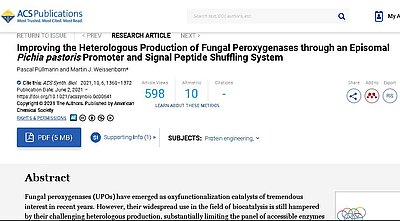Mix the sequences! Better enzyme expression by gene shuffling.
News from the UPO front! Nonspecific peroxygenases (UPOs) of fungal origin are popularly used as biocatalysts due to their ability to catalyze multiple hydroxylation reactions. The search for new UPOs with desired substrate specificities for dedicated synthesis processes is therefore high on the agenda of synthesis chemists right now. However, the production of the desired enzymes in yeasts proves to be difficult, as UPOs are hard to express for various reasons.
The IPB chemists Pascal Püllmann and Martin Weissenborn have now found a remedy. The gene shuffling system they designed can be used to find the best genetic conditions for the expression of enzymes in yeast. For a first test of the system, the Halle scientists combined the genes of three known UPOs with eleven promoter and 17 signal peptide sequences each and introduced the resulting constructs into the industrially used expression yeast Pichia pastoris. The resulting libraries were then screened for UPO-specific activities using colorimetric assays. This allowed the identification of the best promoter-signal peptide combinations, which resulted in good UPO yields upon yeast expression.
The proof of concept was then carried out with two new UPOs that had not yet been expressed in yeast and subsequently with other enzyme classes such as lipases or laccases. In total, the IPB chemists screened about 3200 Pichia transformants of eight different enzymes in this way and investigated the best promoter-signal peptide combinations under different cultivation and induction conditions. In most cases, this selection of the best expression conditions provided promising enzyme yields. The Halle scientists’ knowledge should now benefit other researchers. Therefore, Püllmann and Weissenborn make all plasmids available on the plasmid archive platform Addgene.
</h3p>



